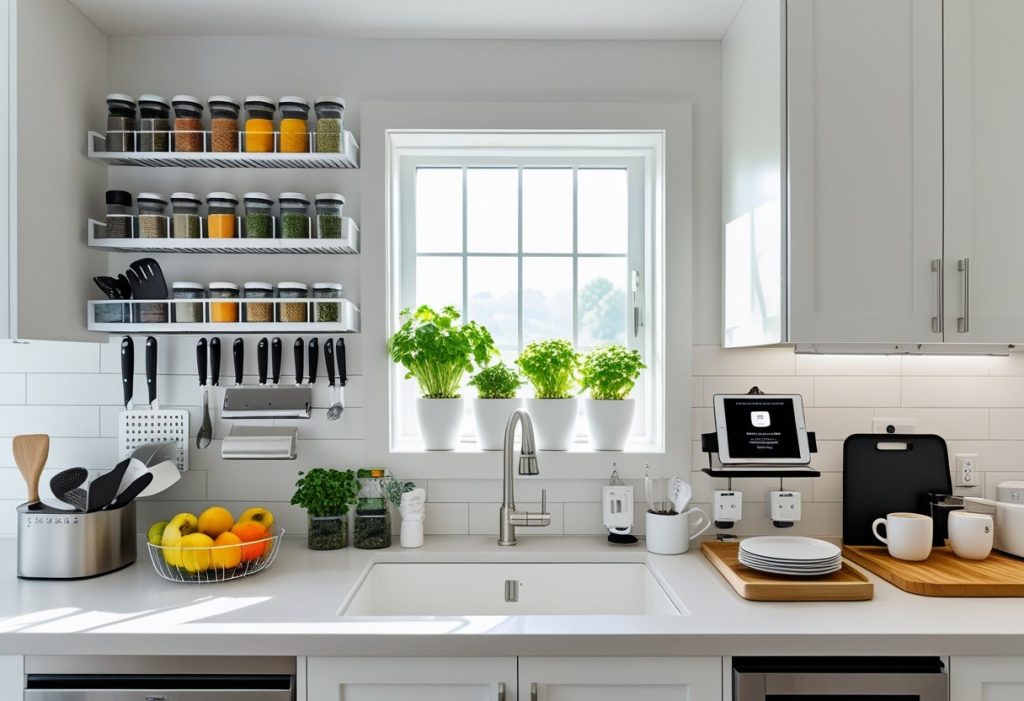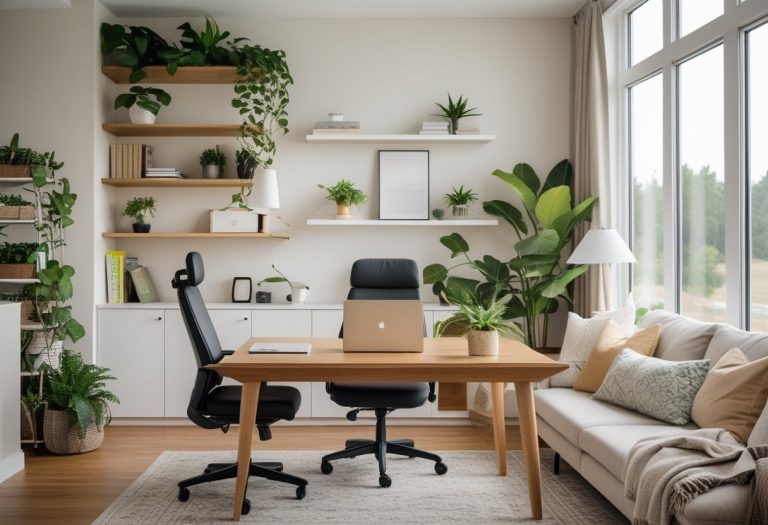15 Smart Kitchen Counter Ideas for Space & Efficiency
A cluttered kitchen counter can create unnecessary stress and reduce the efficiency of meal preparation. Practical organization transforms this space into a functional area where tools and ingredients are easy to find and use. The key to an organized kitchen counter lies in combining smart storage solutions with thoughtful layout choices that maximize available space and keep essentials within reach.

Using vertical space, incorporating multi-purpose containers, and designating specific zones for different tasks all contribute to a clutter-free counter. Efficiently arranged counters not only improve workflow but also enhance the overall look of the kitchen, making it feel cleaner and more inviting.
These 15 clever kitchen counter organization ideas focus on practical methods anyone can apply, no matter the kitchen size. From simple storage hacks to innovative gadgets, each idea aims to keep counters tidy while maintaining accessibility and style.
Decluttering and Evaluating Your Counter Space

To improve kitchen counter organization, start by removing everything from the counters, then focus on identifying which items are essential for daily use. Organizing the space into zones based on activity will enhance both efficiency and overall cleanliness.
Clearing Kitchen Countertops
The first step is to completely clear off the kitchen countertops. Remove all items, including appliances, utensils, and miscellaneous clutter such as mail or keys. This provides a blank slate to better evaluate the available space and see what truly needs to remain.
Next, clean the surfaces thoroughly. A clear and clean counter is easier to maintain and visually signals where storage can be improved. Clearing excess items reduces distractions and helps prevent the accumulation of clutter over time.
Assessing Daily Use Items
With the counters cleared, identify which items get used every day. These should remain accessible but kept tidy. Items such as a coffee maker, frequently used knives, or a toaster often belong here.
Items used less frequently should be stored away to free up space. Categorize tools and appliances by how often they’re used, then prioritize keeping only daily essentials on the counter. This assessment improves the flow of work and lessens visual congestion.
Zoning for Functionality
Dividing the counter into specific zones based on kitchen activities helps streamline tasks. For example, designate an area for food prep near the sink, a baking zone with measuring tools and bowls, and a beverage station with cups and coffee supplies.
Use storage containers and trays to define each zone clearly. This strategy supports both efficiency and a cleaner appearance by reducing cross-use clutter. When zones are well planned, it limits the movement of items and helps maintain order.
Maximizing Countertop Organization with Smart Tools

Smart tools can dramatically improve kitchen counter organization by grouping items efficiently and enhancing accessibility. Devices like trays, jars, and pedestals not only declutter surfaces but also create visually coherent spaces that are easier to clean and maintain.
Using Trays for Grouping Essentials
Trays act as practical units for gathering frequently used items such as oils, spices, or condiments. Instead of scattering these essentials across the countertop, placing them on a tray keeps them contained and easy to move when cleaning or cooking.
Using a tray can also define zones for different kitchen tasks. For example, a tray near the stove might hold cooking oils and herbs, while another by the coffee maker organizes mugs and sugars. This method reduces visual clutter and speeds up kitchen routines.
Materials vary, but trays made from durable, easily cleaned surfaces like melamine or metal offer longevity and low maintenance. Choosing trays with raised edges prevents spills from spreading, further protecting the countertop.
Incorporating Wooden Trays and Pedestals
Wooden trays combine functionality with aesthetic appeal, lending warmth and texture to kitchen counter organization. Their natural material complements many kitchen styles, from modern to rustic, making them versatile organizational tools.
Pedestals, often made of wood, elevate specific items such as fruit bowls or spice racks. This layered approach adds vertical storage without crowding the counter, creating more usable surface area.
Wooden trays and pedestals can also be grouped together. For instance, placing a pedestal on a tray highlights featured items and simplifies repositioning when the counter requires cleaning, improving both practicality and design cohesion.
Clear Jars and Canisters for Dry Goods
Clear jars and canisters are essential for storing dry goods like flour, sugar, pasta, and grains while keeping counters visually tidy. Transparency allows for quick content identification, preventing overbuying and making refills obvious.
Uniform jar sizes and labels enhance the organized look and maximize storage efficiency by facilitating neat stacking or alignment. Airtight lids protect contents and maintain freshness, reducing waste.
Using glass or durable BPA-free plastic jars balances durability with style. Grouping these containers on a wooden tray or dedicated shelf minimizes footprint and creates a dedicated zone for dry goods on the countertop.
Stylish and Functional Storage Solutions

Effective kitchen storage blends practicality with aesthetics to keep counters clear and visually appealing. Choosing the right containers and fixtures can free space, make tools easy to access, and add a stylish touch to the kitchen environment.
Utensil Holders On Display
Utensil holders keep cooking tools organized without hiding them away, making frequently used items easy to grab. Opt for materials like stainless steel, ceramic, or bamboo, which are durable and suit different kitchen designs.
Placing utensil holders near the stove or prep area saves time and limits clutter. Some holders have divided compartments, helping sort spoons, spatulas, and whisks separately. Choosing a design that complements the countertop material can also enhance the overall look.
Regularly decluttering utensils and only storing daily essentials in holders maximizes the benefit. This method also allows the kitchen to appear tidy while maintaining functionality.
Open Shelving Ideas
Open shelves provide visible storage that keeps counters free by relocating items like jars, bowls, and frequently used cookware above the workspace. Shelves in wood, metal, or glass styles can fit both modern and traditional kitchens.
When installing, sturdy brackets and proper spacing ensure shelves hold weight safely. Grouping similar items and using matching containers or labels improves organization and visual harmony.
Open shelving encourages maintaining order since items are always on display. It’s an opportunity to showcase attractive kitchenware while reclaiming counter space.
Magnetic Knife Rack Installations
Magnetic knife racks secure sharp knives on the wall, eliminating bulky knife blocks that consume counter space. These racks are usually stainless steel or wood, balancing durability with style.
Placing the rack near the food prep area offers both convenience and safety, keeping knives out of reach of children. The magnetic strip holds knives firmly while allowing quick removal.
Installing a rack requires ensuring it’s mounted into wall studs for stability. This solution keeps blades visible, organized, and readily accessible without crowding drawers or counters.
Creative Ways to Free Up Counter Space

Maximizing kitchen counter space often requires using vertical and mobile storage solutions. Items that typically sit on counters can be relocated or hung to create more working area and maintain easy access.
Hang Mugs and Cups Under Cabinets
Hanging mugs and cups under cabinets is an effective way to clear counter clutter and keep drinkware accessible. Installing sturdy hooks or a dedicated under-cabinet rack allows mugs to be suspended by their handles.
This method frees up shelf and counter space while adding a decorative element. It is especially useful for frequently used mugs, making them easy to grab. Proper spacing and secure mounting are important to avoid damage or accidents.
Wall-Mounted and Hanging Racks
Wall-mounted and hanging racks offer additional storage without consuming counter space. These racks can hold spices, utensils, or even cutting boards, creating an organized, visible system.
They come in various forms, including magnetic strips for knives or pegboards for flexible hanging. Installing racks near prep areas helps streamline meal preparation and keeps counters clear.
Using Utility Carts and Sideboards
Utility carts and sideboards add portable and extra storage space near the kitchen counter. Carts often include shelves or drawers for storing appliances, cookware, or pantry items that otherwise crowd counters.
They can be moved as needed, offering flexibility and convenience. Sideboards provide a stationary option with surface space and storage compartments, helping to organize items that are not in daily use but need to be accessible.
Establishing Dedicated Countertop Zones

Organizing kitchen counters into specific zones improves efficiency and reduces clutter. Each zone serves a distinct purpose, allowing items and tools to be stored where they are most needed.
Setting Up a Coffee or Beverage Station
Creating a designated coffee or beverage station centralizes all related items in one accessible spot. This includes coffee makers, mugs, sugar, and coffee pods or grounds.
Keeping these necessities grouped reduces daily setup time and mess. Using trays or small shelves helps contain spills and keeps counters tidy. A nearby drawer or basket can store stirrers, napkins, and sweeteners for convenience.
Position the station near a power outlet and away from cooking zones to avoid congestion. This clear separation supports smooth workflow in the kitchen.
Baking and Prep Areas
A baking and preparation zone includes tools like mixing bowls, measuring cups, spatulas, and baking sheets. Keeping frequently used ingredients such as flour, sugar, and spices close by streamlines the baking process.
A countertop organizer or tiered shelf can hold containers and utensils while maximizing vertical space. It is best to have this zone near the stove or oven for easy transfer of prepped items.
Clear counters of unrelated items to allow ample workspace. A clean surface prevents contamination and makes baking more efficient.
Snack and Produce Displays
A visible, attractive display for snacks and fresh produce encourages healthy eating and quick access. This area often features open baskets, bowls, or tiered fruit stands.
Organizing snacks and produce in individual containers can extend freshness and avoid spills. Group items by type, such as fruits on one side and packaged snacks on another, to enhance accessibility.
Keep this zone near the kitchen entrance or refrigerator for easy replenishing and grab-and-go convenience. Proper placement maintains counter cleanliness and balance.
Maintaining a Clutter-Free, Personalized Kitchen

A well-organized kitchen balances efficiency with personal style. Incorporating decorative elements and consistent habits helps sustain order while reflecting individual taste.
Decorative Touches and Greenery
Adding decorative items enhances a kitchen without creating clutter. Small potted plants or herbs placed on windowsills or corner shelves introduce greenery and freshness.
Using containers or holders that match the kitchen’s color scheme keeps essentials like utensils or spices organized and visually appealing.
Decorative trays or bowls can corral frequently used items, making them easy to find and preventing scattered clutter.
Choosing pieces with dual functions—such as attractive storage jars—combines style with practicality, maximizing counter space and maintaining a neat appearance.
Routine Tidying and Habits
Daily habits significantly impact kitchen organization. Regularly clearing counters after each use minimizes buildup of unnecessary items.
Setting a specific time for quick tidying—such as before bed—helps maintain the system and prevents clutter from accumulating.
Encouraging designated spots for all frequently used objects promotes consistency. For example, keys, mail, and phones can have a basket or tray near the entry.
Using labels and clear containers further supports order and makes it easy to return items to their proper places, reducing mess over time.







